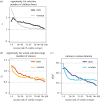A matter of time: Bateman's principles and mating success as count and duration across social strata in contemporary Finland
- PMID: 37434521
- PMCID: PMC10336387
- DOI: 10.1098/rspb.2023.1061
A matter of time: Bateman's principles and mating success as count and duration across social strata in contemporary Finland
Abstract
Bateman's principles heavily influence the understanding of human reproductive behaviour. Yet, few rigorous studies on Bateman's principles in contemporary industrialized populations exist. Most studies use small samples, exclude non-marital unions, and disregard recent insights on within-population heterogeneity in mating strategies. We assess mating success and reproductive success using population-wide Finnish register data on marital and non-marital cohabitations and fertility. We examine variability across social strata in the Bateman principles and analyse the mate count, the cumulated duration with a mate, and the association with reproductive success. Results support Bateman's first and second principles. Regarding Bateman's third principle, the number of mates is more positively associated with reproductive success for men than women, but this association is driven by ever having a mate. Having more than one mate is on average associated with lower reproductive success. However, for men in the lowest income quartile, having more than one mate positively predicts reproductive success. Longer union duration is associated with higher reproductive success, and more so for men. We note that sex differences in the relationship between mating success and reproductive success differ by social strata, and argue that mate duration may be an important component of mating success alongside mate count.
Keywords: Bateman gradient; cohabitation; evolutionary demography; fertility; serial monogamy; sexual selection.
Conflict of interest statement
We declare we have no competing interests.
Figures



References
-
- Arnold SJ. 1994. Bateman's principles and the measurement of sexual selection in plants and animals. Am. Nat. 144, S126-S149. (10.1086/285656) - DOI
-
- Trivers R. 1972. Parental investment and sexual selection. In Sexual selection and the descent of man (ed. Campbell B), pp. 136-179. Chicago, IL: Aldine.
-
- Borgerhoff Mulder M. In press. Bateman's principles & the study of evolutionary demography. In Human evolutionary demography (eds Lee R, Sears R).
-
- Puts D. 2016. Human sexual selection. Curr. Opin. Psychol. 7, 28-32. (10.1016/j.copsyc.2015.07.011) - DOI
-
- Anthes N, Häderer IK, Michiels NK, Janicke T. 2017. Measuring and interpreting sexual selection metrics: evaluation and guidelines. Methods Ecol. Evol. 8, 918-931. (10.1111/2041-210X.12707) - DOI
Publication types
MeSH terms
Associated data
LinkOut - more resources
Full Text Sources

